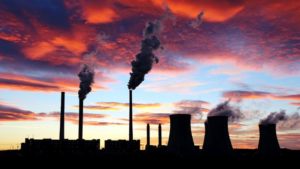Greenhouse gases are the gases that contribute to the greenhouse effect. Examples include carbon dioxide (CO₂), methane (CH₄), nitrous oxide (N₂O) and fluorinated gases. These gases trap heat in the atmosphere by absorbing energy and slowing down the rate at which it escapes into space. The length of time these gases remain in the atmosphere for varies from a few years to thousands of years. The gases also differ in their ability to absorb energy, which is called their ‘radiative efficiency’.
Carbon dioxide
Carbon dioxide is released into the atmosphere when we burn fossil fuels such as coal, natural gas and oil. We burn fossil fuels to provide energy and transport. When solid waste, trees and other biological materials are burnt, carbon dioxide is released into the atmosphere. Chemical reactions that occur through processes such as the manufacture of cement also contribute to carbon dioxide emissions.
Carbon dioxide is removed from the atmosphere when it is absorbed by ‘carbon sinks’. A carbon sink is anything that takes in more carbon than it releases CO₂. For example, plants absorb carbon dioxide in photosynthesis. This process is called the carbon cycle. However, by increasing CO₂ emissions and decreasing the amount of natural ‘sinks’, human activities are disrupting the carbon cycle. Therefore, the levels of CO₂ in the atmosphere have been increasing since the industrial revolution.
According to the 2017 U.K. Greenhouse Gas Emissions Statistical Release, carbon dioxide is the most dominant greenhouse gas, accounting for 81% of the total U.K. greenhouse gas emissions in 2017. However, since the rise in environmental awareness, U.K. net emissions are estimated to have decreased by 37.4%.

Methane
The production and transport of coal, natural gas and oil are responsible for emitting methane. Livestock and agricultural practices also release methane, as well as the decay of organic waste in landfills. Methane remains in the atmosphere for a much shorter period than carbon dioxide. However, methane is much more efficient at trapping radiation, so it has a higher radiative efficiency. Research suggests that over 50% of the methane released into the atmosphere is caused by human activity.
Nitrous Oxide
Nitrous oxide is naturally part of the atmosphere as part of the earth’s nitrogen cycle and has a variety of natural sources. N₂O molecules stay in the atmosphere for an average of 114 years before being removed by a sink or destroyed through chemical reactions. It is also much more efficient than carbon dioxide in its ability to absorb energy.
Nitrous oxide is released into the atmosphere through human activities such as agriculture, fuel combustion, wastewater management and industrial processes. Soil management activities, such as fertiliser application, are also responsible for emitting N₂O. Nitrous oxide is also generated as a by-product when chemicals such as nitric acid are produced. This chemical process is used to make synthetic commercial fertiliser.
Fluorinated gases
Fluorinated gases include hydrofluorocarbons, perfluorocarbons, sulphur hexafluoride and nitrogen trifluoride. These are synthetic greenhouse gases that are emitted through various industrial processes. They are very powerful, which means that they’re sometimes called ‘High Global Warming Potential gases’. Fluorinated gases are also extremely dangerous because they can last for thousands of years. They are often only removed when they are destroyed by sunlight. They also differ from the other greenhouse gases because they have no natural sources. This means they are generated exclusively by human activity.
We use fluorinated gases as substitutes for ozone-depleting substances. For example, hydrofluorocarbons are used as refrigerants in air conditioning systems. They are also used as aerosol propellants, foam blowing agents, solvents and fire retardants. Perfluorocarbons are also generated through various industrial processes. Sulphur hexafluoride is also released in industrial processes, as well as being used as an insulating gas in electrical transmission equipment.
What is the problem with greenhouse gases?
The earth needs a certain amount of greenhouse gases to warm the planet to a liveable temperature. The greenhouse gases absorb energy from the sun and this heats up the earth. This natural process is called the greenhouse effect. The enhanced greenhouse effect refers to increase in concentrations caused by human activities. With more greenhouse gases, global temperatures have started to increase, which has critical consequences for the entire planet. Sea-levels are rising as glaciers melt, which is disrupting biodiversity and habitats. Global warming has also led to climate change, which means more extreme weather conditions such as droughts, hurricanes and floods. This poses a substantial risk to both human health and activities, as well as jeopardising wildlife and putting many species at risk of extinction.


